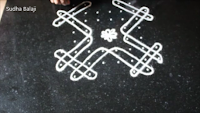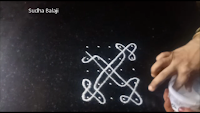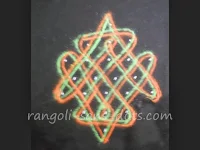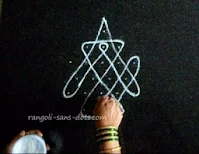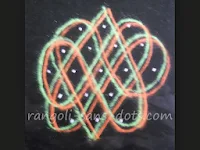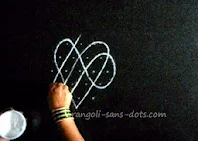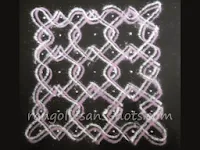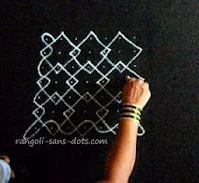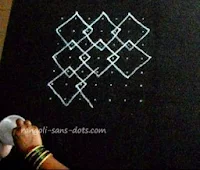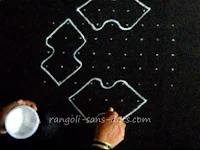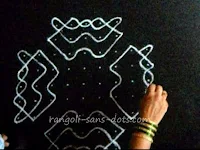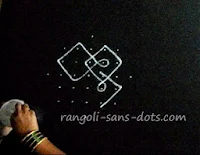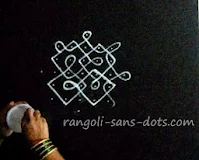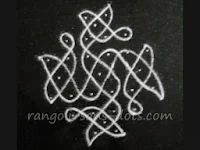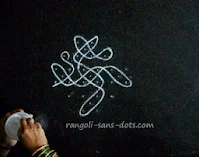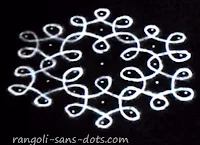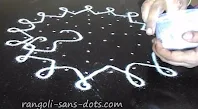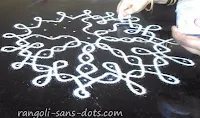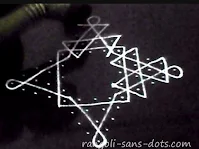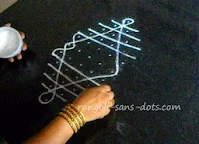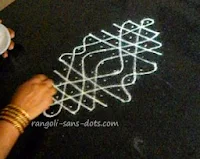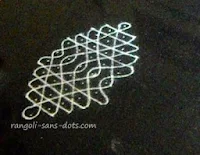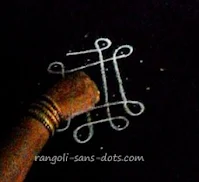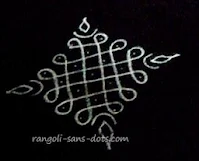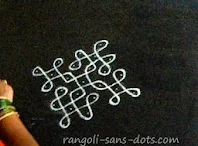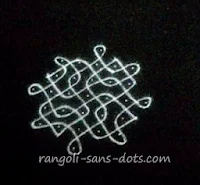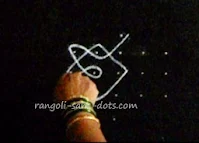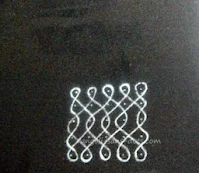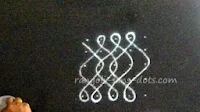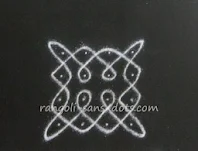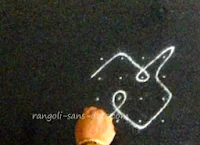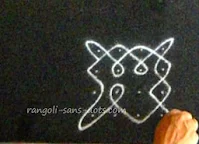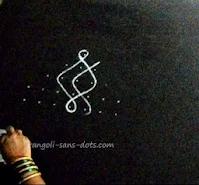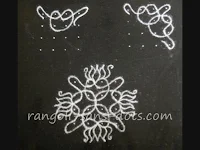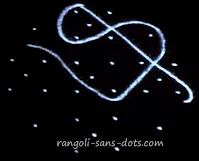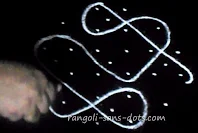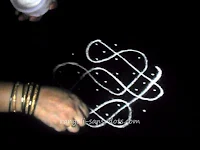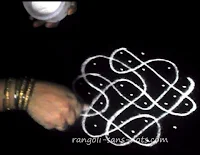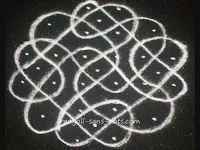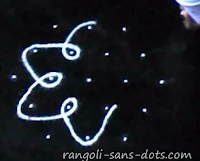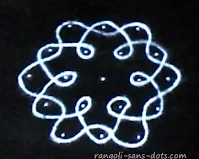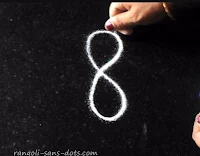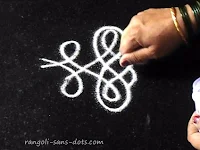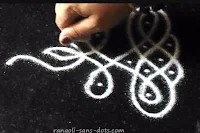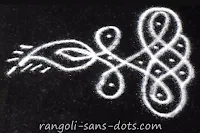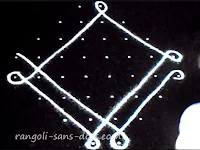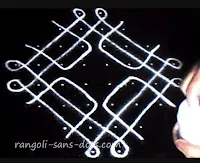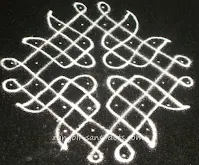Sikku kolam poduvathu eppadi images
Sikku kolam ( சிக்கு கோலங்கள் ) is unique to kolam designs of Tamil Nadu. Sikku means knot. It is obvious that one can get tied up in knots when one tries this type of kolam.
Actually the designs posted so far are very simple. They can be more complicated.
Who ever discovered or invented this variety of kolam, it is a good exercise for the brain not that other varieties are anything less. The final design is usually symmetrical when viewed from any direction
The difference between this type and those with dots is that while in kolam with dots we use up the dots to form a pattern where as in this type it is drawn around the dots.
Of course they can be left plain or colours can be added.
Small and simple sikku kolam Let us start with a simple design. The dot grid used is not standard with two extra dots on eight sides
6 by 6 dots small sikku kolam
Quite an easy and common kolam , like most designs we should not underestimate by the size of the kolam because each one is tricky and has some steps where we can get stuck just like a Math problem For most kolangal I have shared at least one intermediate step.
11 dots sikku kolam
The dot pattern is 11 dots but non standard as shown in the picture with gaps in between . This kolam has lots of twists and turns but still qualifies as a simple kolam since there are more complicated designs.
Some are completed in steps and as a result each steps can have a different colour giving a totally different effect to the kolam.
It is possible to draw them with two parallel lines also if we want to make it more difficult for ourselves! Start from the outside and move towards the centre as against from the centre towards the outside in case of free hand kolam. There are can be many methods to draw them, we have to find the easy or if possible the easiest way through experience.
Sikku kolam and celtic knots have a lot of similarity - this deepam kolam inspired by celtic knots - the pattern has been drawn and then the dots have been placed . The pictures below explain the steps.
Sikku kolam and celtic knots have a lot of similarity - this deepam kolam inspired by celtic knots - the pattern has been drawn and then the dots have been placed . The pictures below explain the steps.
This can also be combined with a free hand design.
It is also called neli kolam or kambi kolam or pinnal kolam. (Pinnal in Tamil refers to the braid or the traditional plait ) The traditional method Some of the simplest sikku kolam designs are given below for reference.
A collection of small sikku kolam and so they are simple too. Such different and unique designs as shown in the photo below can be drawn for Margazhi kolam or Pongal kolam too or Sankranti tippudu muggulu
In any art, there should be liberty for innovation. So this post has been updated with the following colourful neli kolam designs. They are from the kolam designs below but have been drawn with two colours both lines drawn simultaneously.
This method has been uploaded in my YouTube channel and using this method I am updating posts where ever possible with some special kolam designs. Drawing neli kolam with parallel lines is difficult but common. So to try something different, these two designs.
The lines have been drawn with green and yellow colours. How to pick the colours and how to draw the lines refer to the video in the Rangolisansdots my YouTube Channel The two images in black and white (below ) show us how to draw the kolam below. The two images above show the steps with usual white kolam powder.
Probably this and some sikku kolam designs are similar to celtic wire designs for jewellery and resemble some patterns the only difference being that these are drawn with kolam powder while they are made with wires. This us another proof that there are many beautiful art forms in this world and that they have all contributed to the beauty of our world.
This type of sikku kolam is called parangikai or pumpkin kolam because it resembles the shape of a pumpkin.
.
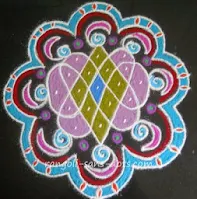
The rangoli on the top has a simple sikku kolam at the centre of dots pattern 5 to 3 ( shown in the previous kolk ). The kolam has been surrounded by a simple rangoli border with two lines. The gap between the kolam and border has been filled with some spiral motifs.
The lines have been drawn with green and yellow colours. How to pick the colours and how to draw the lines refer to the video in the Rangolisansdots my YouTube Channel The two images in black and white (below ) show us how to draw the kolam below. The two images above show the steps with usual white kolam powder.
Probably this and some sikku kolam designs are similar to celtic wire designs for jewellery and resemble some patterns the only difference being that these are drawn with kolam powder while they are made with wires. This us another proof that there are many beautiful art forms in this world and that they have all contributed to the beauty of our world.
This type of sikku kolam is called parangikai or pumpkin kolam because it resembles the shape of a pumpkin.
.

The rangoli on the top has a simple sikku kolam at the centre of dots pattern 5 to 3 ( shown in the previous kolk ). The kolam has been surrounded by a simple rangoli border with two lines. The gap between the kolam and border has been filled with some spiral motifs.
The central design has been filled with brown and pink colours and the inner most design is filled with blue colour. to give a different effect. The border has been filled with blue colours as also the other motifs. The gaps between the spiral patterns is filled with some simple circular designs.
Finally the outer border has some simple designs running perpendicular to the lines. Place the dots again in the sikku kolam after the colours are applied.
Finally the outer border has some simple designs running perpendicular to the lines. Place the dots again in the sikku kolam after the colours are applied.
I wrote that rangolis with dots and those without dots have their own appeal and beauty. Hence I have tried to combine both in the rangoli design above. I understand that they are called gantina rangoli in Kannada to indicate knotted rangoli designs.
The remaining dots can be used to draw a curved snake like continuous pattern and the result the neli kolam below.
For the kolam on the top the dot pattern is 9 in 5 rows and 5 in two rows. While some sikku kolam designs are easy this one can not be considered to be easy and we can go wrong even with practice. Two images showing stages of the kolam. It is easier to split the kolam into patterns as shown in the images to make drawing such designs simpler.
For the kolam on the top. The dot pattern is 7 at the centre, two rows of 5 on either side and then 1 on either side. There may be methods simple and difficult to draw these kolams, to start and end the meandering line. The images below show intermediate steps.
This chikku / kambi kolam design or tippudu muggulu in Telugu - with a 7 by 7 dot pattern and the method is also very simple but two colour combination drawn simultaneously needs some practice.
.While we can draw kolam with parallel lines, picking of two colours for these designs is the trick to be taught or learnt.
Tips for how to pick the colours and draw parallel lines with two different colours are also there in the link 'sikku kolam designs ' (knotted designs ) given above. Two intermediate steps for the sikku kolam for a Deepavali special kolam in the images below
For the kolam on the top. The dot pattern is 7 at the centre, two rows of 5 on either side and then 1 on either side. There may be methods simple and difficult to draw these kolams, to start and end the meandering line. The images below show intermediate steps.
For the kolam on the top that has another non-standard dot pattern the dot grid is placed as follows, 5, 4 (idukku pulli), 5,3 and 1. Then 3 and 1 at the top.
This kolam on the top has a non-standard dot pattern as is the case of many sikku kolam or neli kolam designs. The idea is get a final image that has some symmetry.
Hence the dot pattern for the kolam on the right is 6 and 6 with three dots between any two dots of the six dot line. Then four dots on either side and finally two dots. One dot is placed between four and two dots. Two images showing the intermediate steps for this sikku kolam have been added
The next sikku or chikku kolam uses a 7 by 4 dot grid , idukku pulli with dots placed vertically so that the kolam appears to expand on the sides. The three photos below show the steps to make it easy to draw this beautiful and simple kolam.
Another type of sikku kolam is one that represents a wheel or chakra. Commonly drawn during Margazhi befiore Pongal or Sankranti. The kolam in steps through pictures. We can add more patterns radially to make it more difficult not that this is easy! For the dot pattern and other details please go to the video in my kolam channel .
The final image shows the patterns on the four sides with the space at the centre. We can leave the space as it is or we can fill it with some floral or other designs. Since it is a very small design with little space I have placed only a dot !.
 In this type of design and also in many other designs variations are possible. After all sky is the limit for our imagination. One such variation of this sikku kolam design is shown below. Add lotus patterns on all four sides of the kolam and add a few colours, pink in this colours because the pink is usually associated with lotus.
In this type of design and also in many other designs variations are possible. After all sky is the limit for our imagination. One such variation of this sikku kolam design is shown below. Add lotus patterns on all four sides of the kolam and add a few colours, pink in this colours because the pink is usually associated with lotus.
The dot template is 7 at the centre and 5, 7 and 3 on either side for the sikku kolam on the left
The next sikku or chikku kolam uses a 7 by 4 dot grid , idukku pulli with dots placed vertically so that the kolam appears to expand on the sides. The three photos below show the steps to make it easy to draw this beautiful and simple kolam.
Another type of sikku kolam is one that represents a wheel or chakra. Commonly drawn during Margazhi befiore Pongal or Sankranti. The kolam in steps through pictures. We can add more patterns radially to make it more difficult not that this is easy! For the dot pattern and other details please go to the video in my kolam channel .
Sikku kolam - type kulam kolam
There is a type of sikku kolam called kulam kolam. Kulam is pond in Tamil. In this type we use a square dot grid on four sided with a space in the centre.
Since the space at the centre and the designs on the four sides represent a temple pond and the steps on the four sides respectively it is called a kulam kolam or pond kolam. It is possible to grow the kolam infinitely. In the images below the simplest among them using 2 by 2 dot grid and with four designs is shown.
Kulam kolam theme can also be tried with a dot grid that starts with 4,5,6 etc and tapers to one instead of just the square dot pattern. In the sikku kolam below using 5 dots make a square and then on all the four sides place dots from 4 to 1 as idukku pulli.
Since there is sufficient space I have added a floral pattern at the centre. This also looks like a classical padi kolam where we have steps. A beautiful kolam that can be tried as vasal kolam at the entrance.
 In this type of design and also in many other designs variations are possible. After all sky is the limit for our imagination. One such variation of this sikku kolam design is shown below. Add lotus patterns on all four sides of the kolam and add a few colours, pink in this colours because the pink is usually associated with lotus.
In this type of design and also in many other designs variations are possible. After all sky is the limit for our imagination. One such variation of this sikku kolam design is shown below. Add lotus patterns on all four sides of the kolam and add a few colours, pink in this colours because the pink is usually associated with lotus. The dot template is 7 at the centre and 5, 7 and 3 on either side for the sikku kolam on the left
It is quite normal to see designs above drawn at the entrances of houses in Tamil Nadu. Bigger kolam designs are drawn for festivals and other special occasions
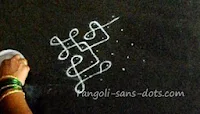
The next neli kolam is with a 5 by 5 dot grid with one dot at the centre outside the grid on all four sides. The images below show three steps to the final design. The first image shows upto a certain level of the kolam and the second image continuation.
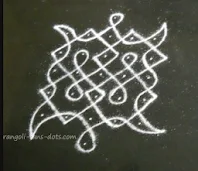
This category or variety of kolam designs are used daily at the entrance. If one watches a lady or girl drawing kolam it can be observed that she carries the kolam powder in a plastic or metallic container after washing the entrance with water, pauses to think , taking out a pinch of kola powder trying to decide what kolam she would draw for the day.
This neli kolam design is also a very simple and straight forward kolam with 5 by 5 dot pattern. This can be drawn independently as a kolam at the entrance or can be a part of a kolam using these patterns at the corners called the kulam kolam ( pond kolam ).
The next neli kolam is also quite a common, simple and easy neli kolam. The important characteristic of this type of neli kolam is that it can be drawn in various sizes by increasing the dot grid.
The result we can draw a very small kolam with three dots or bigger kolam with 5,7,9 dots and so on. This design has been drawn with a dot pattern as shown. Place three rows of 5 dots each. Then place 4,3,2 and 1 dot on either side ( idukku pulli ).
For 7 dots kolam place three rows of 7 dots with 6 to 1 dot on either side as idukku pulli.
First draw the outermost twisted pattern connecting the topmost and bottom most dots. Then draw the four lines on either side. Finally connect the top and bottom lines through curved lines as shown. The result is a small but cute sikku kolam.
The next neli kolam uses a five by five dot grid. One of the simplest neli or chikku kolam designs because the dot grid used is square and also because there more straight lines than most neli kolangal.
The images show the completed design and an intermediate step.
The outer designs are similar to lamps. We can change them according to our imagination or can continue the kolam around the four outer dots too.
Neli kolam or chikku kolam or suzhi kolam
One of the common kolam designs underr the pulli vecha kolam designs of Tamil Nadu.
Sikku kolam is also called neli kolam ( melikala muggulu ) One of the meanings of neli in Tamil is wriggle or twist. Probably because of the twisted nature of the kolam sikku kolam is also called neli kolam.
My father-in-law used to quote from literature - a rose by any other name smells as sweet. Similarly sikku or neli kolam they are unique in kolam patterns and are beautiful and challenging.
Even the simplest designs can be challenging at least the first time. The kolam below the first in this series. The dot pattern is 7-5-3-1 with 5-3-1 on either side of 7 dots.
Even the simplest designs can be challenging at least the first time. The kolam below the first in this series. The dot pattern is 7-5-3-1 with 5-3-1 on either side of 7 dots.
The first image shows the beginning of the kolam and the second image shows the continuation of the kolam. Like any other dotted kolam there may be easier methods. This is quite a common neli kolam design and is found drawn at the entrance. It can be drawn with parallel lines also.

The next neli kolam is with a 5 by 5 dot grid with one dot at the centre outside the grid on all four sides. The images below show three steps to the final design. The first image shows upto a certain level of the kolam and the second image continuation.
Though it is possible to decide how to draw this kolam by concentrating on the path taken by the lines - two images - thumbnails from the video taken for this kolam has been added.
The next neli kolam is also with a 5 by 5 dot grid ( chukki ) but instead of four single dots on four sides outside the dot grid in this kolam we have only two more dots one at the top and one at the bottom As usual two photos showing the intermediate steps in this simple kolam that can be drawn as "daily kolam design " at the entrance.
The next neli kolam is also with a 5 by 5 dot grid ( chukki ) but instead of four single dots on four sides outside the dot grid in this kolam we have only two more dots one at the top and one at the bottom As usual two photos showing the intermediate steps in this simple kolam that can be drawn as "daily kolam design " at the entrance.

This category or variety of kolam designs are used daily at the entrance. If one watches a lady or girl drawing kolam it can be observed that she carries the kolam powder in a plastic or metallic container after washing the entrance with water, pauses to think , taking out a pinch of kola powder trying to decide what kolam she would draw for the day.
If she is not able to decide among the many designs she knows, she bends to draw a simple design. The one below is one such design that is quite commonly used.
The dot pattern used is 5 by 3 with one dot on either side.
The dot pattern used is 5 by 3 with one dot on either side.
This neli kolam design is also a very simple and straight forward kolam with 5 by 5 dot pattern. This can be drawn independently as a kolam at the entrance or can be a part of a kolam using these patterns at the corners called the kulam kolam ( pond kolam ).
Neli kolam are also called suzhi kolam. Suzhi means loop or ring. It may also mean zero. Since neli kolam results in the formation of loops (probably ) it is called so too.
Neli kolam or sikku kolam are drawn frequently for daily kolam designs. The simplest of them with 3 , 4 or 5 dots can be drawn where space is a constraint. One such simple design with a 4 by 4 dot pattern with two images showing how the line curves in and out to get the final beautiful symmetrical design.
Three rows of dots are placed. The number of dots in each row will be odd in number since the pattern repeats after 1-3, 3-5, 5-7 and so on.
As shown in the image draw the repeating rhombus like patterns covering 1 to 3, 3 to 5 etc. Then draw the neli kolam patterns using up the dots in the upper and lower rows.
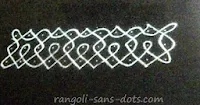

Sikku kolam type borders or chukki rangoli border
This design has a dot pattern 7,7,5,3,1 as shown. The kolam is drawn around the dots. Start with the fourth dot at the bottom.
The line connects this dot, the one at the top and the second and fourth dot in the third row. The remaining dots are used to get symmetric patterns to the left and right of the centre.
In case of doubt please visit Rangolisansdots - my YouTube channel to know the method. I have decorated the finished kolam with a lotus and lamps. During my recent visit to Karnataka,
In case of doubt please visit Rangolisansdots - my YouTube channel to know the method. I have decorated the finished kolam with a lotus and lamps. During my recent visit to Karnataka,
I was humbled to see simple yet beautiful kolam drawn at the entrance of many homes, big and small. It also made me very happy that this tradition is continuing to flourish in many parts of our country.
For the next sikku kolam that looks like a celtic knot - place the dot pattern as shown in the image below.
Sikku kolam and celtic knot designs have a lot of similarities. This deepam kolam or diya rangoli has been drawn inspired by celtic knots, the pattern is drawn and then the dots have been placed. The pictures below show the steps. Probably we can call it celtic knot kolam !
Sikku kolam / Tippudu muggulu with dots pattern 8 to 2
This is common sikku kolam that can be modified to represent birds
This is a common sikku kolam with dot pattern 9 to 1 and hence this sikku kolam can be drawn during Margazhi when relatively bigger designs are drawn. This kolam can be drawn independently or in combination with some free hand designs all around as a simple sikku kolam for Margazhi season.
These are dots visible rangoli or muggulu ( kolam ) and so the beauty is totally different.
small sikku kolam with 4 dots
The next image on the left shows the knotted variety of rangoli or kolam design that is unique to Tamil Nadu. It has been drawn with a four by four dot pattern.
It invariably starts and ends at the same place it is usually drawn as a continuous loop or in some cases the patterns are drawn around the dots individually around which an endless line is drawn around the dots to get the final design.
These designs can be very challenging and so I have added a simple rangoli design. Also four lotus patterns have been added on four sides to get a different design. More such designs are there in knotted rangoli designs.
The next kolami is also the same sikku kolam with a 4 by 4 dot pattern. Only the final decorations have been changed. Instead of lotus designs I have used vilakku (lamps) and floral petals.Two images showing the intermediate steps.
 |
For the next sikku kolam that looks like a celtic knot - place the dot pattern as shown in the image below.
One set of dots has four dots at four corners and one at the middle. Place five such sets of dots as shownin the photo. The first set at the centre and the remaining four sets on the four sides of the first set. Then place four more dots at the centre of any two sets of dots as shown.
The remaining four photos show the steps for drawing this small but complicated kolam.
5 to 3 dots sikku kolam
Using a 5 to 3 dots idukku pulli pattern a simple sikku kolam - steps are through the images can be drawn separately or as part of a bigger design.
Sikku kolam and celtic knot designs have a lot of similarities. This deepam kolam or diya rangoli has been drawn inspired by celtic knots, the pattern is drawn and then the dots have been placed. The pictures below show the steps. Probably we can call it celtic knot kolam !
Sikku kolam / Tippudu muggulu with dots pattern 8 to 2
This is common sikku kolam that can be modified to represent birds
sikku kolam or tippudu muggulu - 9 dots to 1
These are dots visible rangoli or muggulu ( kolam ) and so the beauty is totally different.

